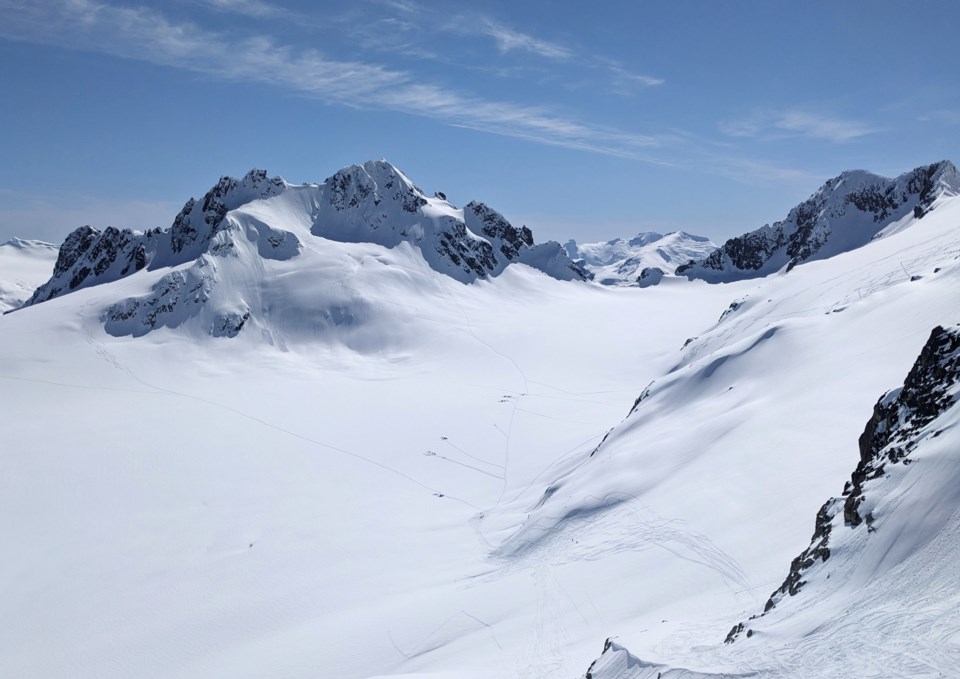On the final weekend of operation of Blackcomb Mountain, I joined four friends for a lap around the Spearhead Traverse. No cushy Kees and Claire Hut, no massive packs ladened with multi-day camping equipment and supplies. Just our day-trip gear with enough food and water to last the 35-kilometre slog around the glaciers.
We all knew it would be a busy day in the Spearhead. It was a Saturday and we were in the midst of sunny April weather. Blackcomb—and arguably more importantly, its lift access to the Spearhead—was in its final days.
Even with all these contributing factors, I never expected to find this many people, this deep, in the Spearhead Range. Normally, once you get past the Pattison-Trorey col, the ski-touring traffic drops off dramatically. Not this day. There seemed to be more people attempting the Spearhead Traverse than day trippers in the Blackcomb backcountry. One couple we met along the way had camped overnight on the edge of Ripsaw Glacier and had seen 13 groups come by just that morning.
The popularity isn’t all a bad thing. It’s great to see backcountry skiers responsibly venturing this deep. Pretty much every group we encountered seemed to have their wits about them and were equipped with the right gear to be travelling on such remote glaciers (namely travelling with harnesses on with crevasse rescue gear at the ready).The downside was skiing slopes along the traverse that looked like resort slackcountry lines, but if you’re touring the Spearhead in a day, you’re not really out here just for the skiing. It’s more about getting into the mountains you don’t get to see every day from the resort lifts.
But there’s another downside to so many people travelling the Spearhead Traverse: poop.
Ten to 15 years ago when backcountry skiing was starting to get more popular, the stewards of the Whistler backcountry knew there was going to come a time when the amount of excrement dropped on those glaciers was going to cause issues. Managing human waste was actually a big part of the impetus for the Spearhead Huts project, though not one that’s nearly as compelling to advertise as comfortable backcountry lodging.
When our group circled around Iago Peak, we saw at least four campsites on Diavolo Glacier. I couldn’t count the number of skiers, but judging by the size of the camps, I’d estimate between 16 and 20 people spent multiple nights there. The shit is starting to add up.
I took a look at how other popular North American glacier parks handle human waste. Denali National Park and Preserve in Alaska—the access to the continent’s highest peak, Denali—is a mountaineering destination for climbers from all over the world. Expeditions can take as long as three weeks, with dozens of climbers winter camping at the various camps. Between 1951 and 2012, climbers have deposited at least 70 metric tonnes of human waste in the Kahiltna Glacier.
The “pack-in-pack-out” policy for trash began in the late 1970s in Denali, but in the ’80s many climbers were getting sick due to contamination of the snow around the camps. It’s now mandated for all climbers to take care of their own poop with designated Clean Mountain Cans (CMC), which are light and sealable receptacles issued to climbing teams by the park rangers. Climbers are allowed to chuck their biodegradable-bagged loads into one designated (read: quite deep) crevasse near camp at 4,267 metres, but otherwise they have to port their poo around the mountain. The CMC program has been very successful in reducing the human-waste pollution in Denali, especially around the high-altitude camps.
The Spearhead Traverse is one of the most popular multi-day ski-touring routes in North America, and it’s only getting busier. The vermiculture (worm) compost toilets at Kees and Claire Hut are doing a great job at managing the poop from the Fitzsimmon Range (Whistler) side of the traverse, and the next hut planned by Mount Macbeth will likely alleviate some of the mid-route calls of nature. But the remaining Spearhead Huts are still a few years from completion, leaving skiers with little choice when they need to take a dump. And winter camping is always going to be a thing along the Spearhead, as the Diavolo Glacier tent city demonstrated. This spot is at least two hours of travel from the nearest outhouse, even when all three Spearhead Huts are complete.
If you own a dog or have raised a child, you’ve come to terms with handling poo as part of your day. You bag it, carry it to the nearest receptacle and get on with life. Special-gas-impervious, double-walled waste bags specific for wilderness situations are available for a few bucks at backcountry stores.
Hopefully, the experienced Spearhead travellers (such as guides) are setting the example. If you do need to go and aren’t equipped with backcountry poo bags, make sure to walk far from regular camps or lunch spots and make sure to burn your toilet paper.
Shit’s getting real on the Spearhead. Let’s normalize carrying it around.
Vince Shuley tries his best to go before he leaves the house. For questions, comments or suggestions for The Outsider, email [email protected] or Instagram @whis_vince.




